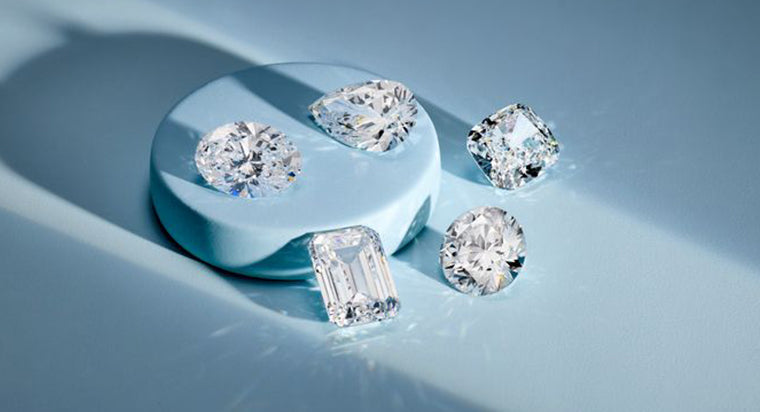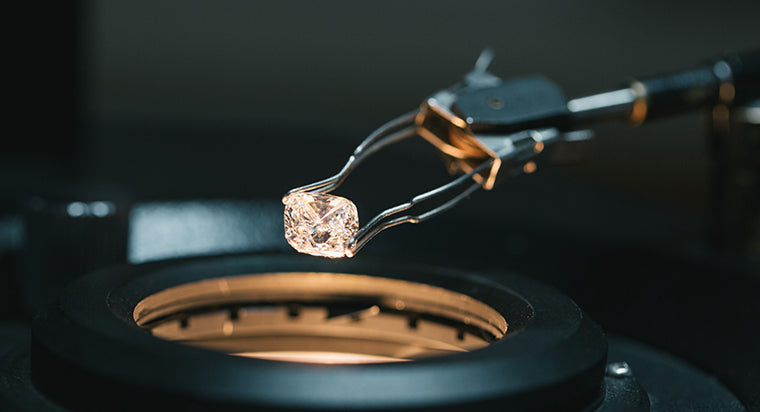Lab Diamonds Shapes

Unlike Cubic Zirconia and Moissanite , lab-grown diamonds are chemically identical to mined diamonds. Their look and sparkle are truly the same as natural diamonds. Lab diamonds are available in all the popular shapes that natural diamonds are available in when it comes to making jewelry.
TABLE OF CONTENTS
How are Lab Diamonds Made?
Laboratories grow these stones from pure carbon using specialized machinery. In High Pressure, High Temperature (HPHT) manufacturing, small diamond fragments are used as a tiny seed for new crystals. These are placed in a machine that operates under extremely high temperatures and pressures, depositing carbon onto the new diamond crystal.
The other process, called Chemical Vapor Deposition (CVD), uses carbon-rich gas and lasers to deposit the carbon onto the diamond “seeds.”
How were Lab Diamonds First Made--How are they Made Now?
In the past, both of these processes generated mainly industrial-grad lab diamonds, but in the past 10 years or so, gem-quality material has become commercially viable. Best of all, lab-created diamonds are visually indistinguishable for consumers, and even specialists require expensive equipment to tell them apart.
How are Lab Created Diamonds Priced and Valued?
When pricing and valuing lab-created diamonds, the same basic criteria are used in evaluations as are applied to natural diamonds. For this reason, we can compare lab-grown and natural diamonds in an “apples to apples” fashion with their traditional counterparts. In other words, lab diamonds are evaluated according to the 4 Cs, which are described by the IGI.
This means that we can talk about shape, cut, and other particular diamond grading on the same terms. Here, we’d like to focus on a topic not covered by the 4 Cs, and that is shape.
Many people think that “cut” is the same as “shape,” but that is not accurate. Instead, “cut” refers to how well a gemstone has been shaped by the gem cutter. In other words, was a quality job done, or was the “best” shape chosen for a particular stone?
How does a gem cutter decide on what shape to create?
Gem cutters, also called lapidaries, choose the future shape of any gem carefully. Lab-created diamonds are no different than any other stone in this respect. First, the stone is examined to determine if it is a good candidate for a faceted cut. Sometimes, this will be obvious, like with an opaque stone, and sometimes a good light and magnifier are needed. Then, the lapidary looks to examine the crystal structure.
Maybe that stone has inclusions (flaws) in a particular area that can either be cut out or hidden by facets, for example. Ultimately, for faceted stones the goal can be to get the most “fire” or sparkle, to maximize the size of the stone, or any combination of related factors. Lapidaries must also ensure that they choose the right shape for a stone’s crystal structure, to avoid accidentally destroying it. The extent to which a lapidary achieves a good cut within a given shape determines the “cut” rating later given by a gemology lab like the IGI.
All of With Clarity lab diamonds are IGI-certified because we want you to shop with confidence.
What are the most popular lab diamond shapes?
Lab-created diamonds, like any gem, come in a variety of shapes. By far the most popular shape is the round brilliant, and this is true regardless of the type of diamond. It isn’t surprising, given that this shape has more fire than any other option. Similarly, the oval cut is another popular shape, since it has the “curb appeal” of seeming larger than it is.
Want a lab-grown diamond that looks larger than it is? Consider a marquise, pear, or cushion stone. Because these shapes require less of the original stone to be cut away, they are also economical for the purchaser.
In other words, these shapes require a smaller rough stone to produce the same weight of finished gem than certain other shapes, including brilliant. Actually, brilliant-cut stones are pretty wasteful in that regard! Oval, cushion, asscher, and emerald stones are also excellent choices. Something that makes fancy shaped gemstones a bit more affordable is the way the rough diamond forms in the laboratory growth process. The lab roughs allow for more of the round brilliant to be cut. This makes the stones more on par with the fancy shapes.

Keep in mind, choosing the lab diamond shape should also influence the clarity and color choices as well. That’s because gem shapes are partially chosen to hide flaws, and even lab-grown diamonds can have poor color or large inclusions. Therefore, if your budget requires that you choose a diamond with more of a yellow tinge or a larger inclusion, you might not want to choose a shape that makes this more obvious. For example, an emerald cut is often terrible in both of these situations, because it shows almost everything in the stone and makes color very obvious. Meanwhile, in this lab diamonds with brilliant cuts are more flaw-friendly.
Want something unique and romantic? At With Clarity, we have a variety of pear shaped lab diamonds. Pear shaped diamonds are a relatively economical choice. For one thing, they don’t require a lapidary to cut away quite so much of the original diamond rough. Furthermore, a pear shaped lab diamond ring is normally worn with the point of the diamond towards the wearer’s heart. We think that’s poignant for an engagement ring.
Final thoughts about price and lab diamonds:
Let’s say that you want a pear shaped lab created diamond for your ring setting. At With Clarity’s current prices, for a 1 carat pear-shaped lab stone, generally, you could be saving about 88% less than a 1 carat pear-shaped natural diamond (the percentage depending on the carat weight, color, clarity, and cut grade).
If you are on a small budget, it is worth knowing that at With Clarity, you will pay about 25%-75% less when purchasing a lab diamond versus a natural diamond (prices vary depending on diamond grading). At With Clarity we believe in options because we know that every life and love story is unique. Learn more about carat weight and cost.
Regardless of the shape of the stone you choose, even the brilliant cut, which is the most expensive by weight. Speak with a gemologist to learn more about the different lab diamond shapes that are available and how to balance other characteristics to obtain the perfect diamond for you.
FAQs
Which are the most popular lab diamond shapes?
Just like any other gem, lab grown diamonds come in a variety of shapes, with brilliant round being the most popular as it exudes an unmatched fire and brilliance. Other much-loved options include the oval cut, marquise, asscher, pear, or cushion.
Which lab diamond shape is best at hiding flaws?
Brilliant round, brilliant oval, and brilliant princess cut are some of the best shapes for maximizing sparkle and minimizing the appearance of inclusions.
Which lab diamond shape is the most romantic?
Heart-shaped lab diamonds are the ultimate symbols of love and romance. Other popular options include princess, asscher, and radiant lab diamonds.
Where can I buy a good lab diamond online?
You can buy good quality lab diamonds from a reputed online brand, such as With Clarity. Here it's easy to find certified lab diamonds based on your budget and preference.
Which lab diamond shape will look larger than it is?
Marquise, pear, and cushion lab diamonds are the preferred choice if you’re looking for a shape that looks bigger than its actual carat weight









